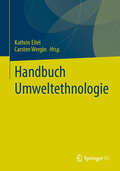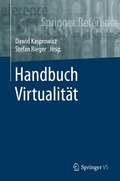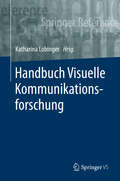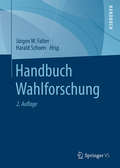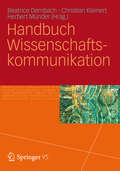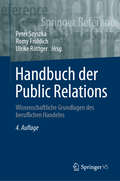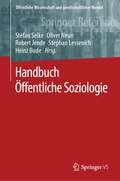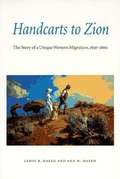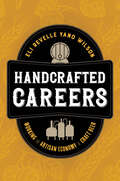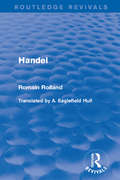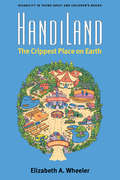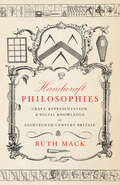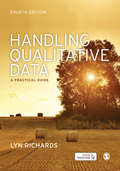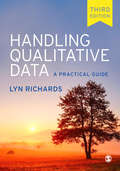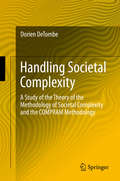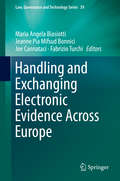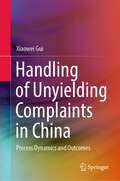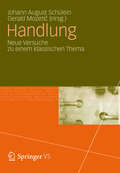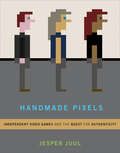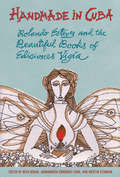- Table View
- List View
Handbuch Umweltethnologie
by Carsten Wergin Kathrin EitelDas „Handbuch Umweltethnologie“ bildet den Stand der Forschung der Umweltethnologie ab und beleuchtet die komplexen Mensch-Umwelt-Beziehungen. Es untersucht, wie kulturelle und soziale Wechselwirkungen diese Verhältnisse gestalten und verändern und legt besonderes Augenmerk auf die unterschiedlichen Konstruktionen und Verständnisse von Naturen und Kulturen sowie auf die Dynamik zwischen Mensch, Kultur und Umwelt.
Handbuch Umweltsoziologie
by Matthias Groß Marco Sonnberger Alena BleicherDas Handbuch Umweltsoziologie bietet eine umfassende und aktuelle Übersicht über das breite und dynamische soziologische Forschungsfeld zum Natur-Gesellschaftsverhältnis. Es führt in die aktuellen theoretischen und methodischen Ansätze im nationalen und internationalen Kontext sowie zukunftsweisende Forschungs- und Praxisfelder ein. Das Handbuch zeigt darüber hinaus die Herausforderungen und Chancen der umweltsoziologischen Forschung in Kooperation mit anderen Disziplinen auf.
Handbuch Virtualität
by Stefan Rieger Dawid KasprowiczDas Handbuch positioniert den inflationär gebrauchten Begriff „Virtualität“ neu. Er soll nicht länger einen Ausnahmetatbestand unserer Gegenwartskultur bezeichnen. Auch soll er nicht länger auf bestimmte Bereiche (Unterhaltung, Computerspiel) beschränkt bleiben. Vielmehr hat er inzwischen Normalität erlangt und soll in eben dieser Normalität auch beschrieben werden. Dazu werden in Fallstudien sehr unterschiedliche Schauplätze in den Blick genommen, die in der Lebenswelt verankert sind: Diese reichen von der Pädagogik bis zur Medizin, von der Kunst bis zur Industrie, von einer veränderten Kriegsführung bis zu alternativen Konzepten von Autorschaft.
Handbuch Visuelle Kommunikationsforschung
by Katharina LobingerDas Handbuch liefert einen umfassenden Einblick in zentrale Theorien, Forschungsfelder, Methoden und aktuelle Herausforderungen der Visuellen Kommunikationsforschung. Ziel ist es, einen State of the Art-Überblick über das dynamische Forschungsfeld zu geben, dabei traditionelle wie innovative Themenbereiche abzubilden, methodische Anleitungen zu geben und für kritische Aspekte der visuellen Forschung zu sensibilisieren.
Handbuch Wahlforschung
by Jürgen W. Falter and Harald SchoenDie empirische Wahlforschung zählt zu den theoretisch und methodisch am weitesten entwickelten, von der Öffentlichkeit am stärksten beachteten Zweigen der Politikwissenschaft. Dieser Band vermittelt Grundlagenwissen über die zentralen Konzepte, Methoden und Befunde der empirischen Wahlforschung und gibt einen Überblick über den aktuellen Stand der Forschung. Den Schwerpunkt bilden theoretische Ansätze zur Erklärung von Wahlverhalten. Sie werden ausführlich dargestellt, kritisch diskutiert und systematisch miteinander verglichen. Daneben geht der Band auf ausgewählte Themen der Wahlforschung ein, u.a. auf Nichtwahl, Wechselwahl, die Wahl extremer Parteien sowie den Einfluss von Wertorientierungen und Massenmedien auf das Wahlverhalten. Ferner enthält er Überblicke über die Geschichte demokratischer Wahlen, die Historische Wahlforschung, die Wahlsystemforschung und die Wahlkampfforschung. Dieser Band bietet auf neuestem Stand einen umfassenden Überblick über die empirische Wahlforschung und trägt dazu bei, ihre Möglichkeiten und Grenzen realistisch zu beurteilen.
Handbuch Wissenschaftskommunikation
by Herbert Münder Christian Kleinert Beatrice DernbachDer Band bietet einen Überblick über die Wissenschaftskommunikation unter vielen Perspektiven: Ausgehend von den politischen, ökonomischen und sozialen Rahmenbedingungen, unter denen Wissenschaft und Wissenschaftskommunikation stattfinden, werden die institutionellen Akteure auf nationaler und internationaler Ebene sowie Best-practice-Beispiele vorgestellt. Thematisiert werden ebenso die Perspektive der Wissenschaftskommunikation als Risiko- und Krisenkommunikation, das Verhältnis von Wissenschaftskommunikation zu Medien und Journalismus sowie die Evaluation von Wissenschaftskommunikation.
Handbuch der Literaturen aus Czernowitz und der Bukowina
by Steffen Höhne Markus Winkler Andrei Corbea-Hoişie Oxana MatiychukDas Handbuch behandelt die multilinguale Literaturlandschaft Bukowina mit ihrem zentralen Ort Czernowitz (Cernăuţi, Černivci, Czerniowce) vom ausgehenden 18. Jahrhundert bis zur Gegenwart. Unter Berücksichtigung unterschiedlicher kultureller, konfessioneller und politischer Orientierungen, Prägungen und Interessen werden sowohl die nationalphilologischen Traditionen und Kanonisierungen als auch die komplexen und kontinuierlichen Austausch-, Übersetzungs- und Verflechtungsprozesse in den Blick genommen. Dabei wird insbesondere auch der rumänische und ukrainische Forschungsstand zu dieser Region betrachtet. Neben der Forschungsgeschichte der Region und theoretischen Konzepten (Interkulturalität und Raum) werden die kultur-, medien- und literaturgeschichtlichen Phasen sowie einzelne Akteure, Themen und Motive behandelt. Eine biographische Übersicht mit Lebensdaten der wichtigsten literarischen Repräsentanten der Bukowina beschließt den Band. - Die Bukowina kann als Paradigma einer polykulturell und -lingual verfassten Region verstanden werden, deren literarisch-kulturelles Erbe Wirkungen über die politischen Brüche von 1918, 1940/41 bzw. 1944 und 1991 hinaus entfaltet.
Handbuch der Public Relations: Wissenschaftliche Grundlagen des beruflichen Handelns
by Romy Fröhlich Ulrike Röttger Peter SzyszkaDas Handbuch führt die Wissensbestände der ‚Public Relations/Organisationskommunikation‘ zusammen und berücksichtigt dabei zentrale Aspekte der PR-Praxis. Die Beiträge aus verschiedenen theoretischen Perspektiven bieten eine Einführung in die wissenschaftliche Beschäftigung mit dem Phänomen PR. Hierfür liefert der Band einen Blick aus unterschiedlichen sozialwissenschaftlichen Disziplinen und bietet eine breit angelegte Darstellung diverser Ansätze und Modelle. Schlüsselbegriffe, die den Fachdiskurs wesentlich prägen, werden ausführlich erläutert. Für die vierte Auflage wurden die Beiträge grundlegend überarbeitet und aktualisiert sowie teilweise neu zugeschnitten.Das Handbuchprojekt wurde mitbegründet von Dr. Günter Bentele, emeritierter Professor am Institut für Kommunikations- und Medienwissenschaft der Universität Leipzig.
Handbuch Öffentliche Soziologie (Öffentliche Wissenschaft und gesellschaftlicher Wandel)
by Stephan Lessenich Heinz Bude Stefan Selke Oliver Neun Robert JendeDas Handbuch ist das erste im deutschsprachigen Raum, in dem Geschichte, Theorie und Praxisfelder der Öffentlichen Soziologie umrissen werden. Damit wird einerseits an die Tradition der Public Sociology angeknüpft, andererseits aber auf die Relevanz einer kritisch reflektierenden Soziologie verwiesen, die ihre Bezugspunkte auch außerhalb der Disziplin findet.
Handcarts to Zion: The Story of a Unique Western Migration, 1856-1860
by Leroy R. Hafen Ann W. HafenIt is unparalleled in history, the procession of Latter-Day Saints pushing handcarts from Iowa City and Florence (Omaha) to their promised Zion by the Great Salt Lake. Many of the three thousand hardy souls who trudged across thirteen hundred miles of prairie, desert, and mountain from 1856 to 1860 were European converts to the Mormon faith. Without funds for wagons and oxen, they carried their possessions in two-wheeled carts powered and aided by their own muscle and blood. Some of the weary travelers would finally be welcomed by their brethren in Salt Lake City; others would go to wayside graves or get caught in early winter storms in the Rockies and hope to be rescued by the parties sent out by Brigham Young. The migration is described in Handcarts to Zion, which draws on diaries and reports of the participants, rosters of the ten companies, and a collection of the songs sung on the trail and at "The Gathering. " LeRoy R. Hafen and Ann W. Hafen dedicated the book to his mother, Mary Ann Hafen, who wrote about the long journey in Recollections of a Handcart Pioneer of 1860: A Woman's Life on the Mormon Frontier, also a Bison Book.
Handcrafted Careers: Working the Artisan Economy of Craft Beer
by Eli Revelle WilsonUnpacks the problems and privileges of pursuing a career of passion by exploring work inside craft breweries. As workers attempt new modes of employment in the era of the Great Resignation, they face a labor landscape that is increasingly uncertain and stubbornly unequal. With Handcrafted Careers, sociologist Eli Revelle Yano Wilson dives headfirst into the everyday lives of workers in the craft beer industry to address key questions facing American workers today: about what makes a good career, who gets to have one, and how careers progress without established models. Wilson argues that what ends up contributing to divergent career paths in craft beer is a complex interplay of social connections, personal tastes, and cultural ideas, as well as exclusionary industry structures. The culture of work in craft beer is based around "bearded white guy" ideals that are gendered and racialized in ways that limit the advancement of women and people of color. A fresh perspective on niche industries, Handcrafted Careers offers sharp insights into how people navigate worlds of work that promote ideas of authenticity and passion-filled careers even amid instability.
Handel (Routledge Revivals)
by Romain RollandRolland’s biography attempts to provide an overview of Handel’s life and works from his early lessons in music to the classical context in which he is commonly placed. Originally published in English in 1916, Hull’s translation gives an insight into biographical facts and the musical pieces composed by Handel including his operas, oratorios and chamber music. This title will be of interest to students of music and musical history.
Handeln in Organisationen der Migrationsgesellschaft: Differenz- und machttheoretische Reflexionen einer praxisorientierten Fortbildungsreihe
by Paul Mecheril Matthias RanggerAnhand der Interpretation empirischer Daten aus der ethnographischen Begleitung einer praxisreflexiv angelegten Fortbildungsreihe zu pädagogischer Professionalität in der Migrationsarbeit werden im Buch Anforderungen an das Handeln in Organisationen der Migrationsgesellschaft untersucht und herausgestellt. Diese finden sich vor allem in den eingelagerten Wissensbeständen der Organisationen sowie den gesellschaftlichen und den regulativ-politischen Vorgaben, mit denen Professionelle konfrontiert sind. Mit dem Fokus auf migrationsgesellschaftliche Öffnung zielt das Buch auf die Explikation organisationaler Bedingungen der Ermöglichung professionellen Handelns in migrationsgesellschaftlichen Differenz- und Machtverhältnissen.
HandiLand: The Crippest Place on Earth (Corporealities: Discourses Of Disability)
by Elizabeth A WheelerHandiLand looks at young adult novels, fantasy series, graphic memoirs, and picture books of the last 25 years in which characters with disabilities take center stage for the first time. These books take what others regard as weaknesses—for instance, Harry Potter’s headaches or Hazel Lancaster’s oxygen tank—and redefine them as part of the hero’s journey. HandiLand places this movement from sidekick to hero in the political contexts of disability rights movements in the United States, the United Kingdom, and Ghana. Elizabeth A. Wheeler invokes the fantasy of HandiLand, an ideal society ready for young people with disabilities before they get there, as a yardstick to measure how far we’ve come and how far we still need to go toward the goal of total inclusion. The book moves through the public spaces young people with disabilities have entered, including schools, nature, and online communities. As a disabled person and parent of children with disabilities, Wheeler offers an inside look into families who collude with their kids in shaping a better world. Moving, funny, and beautifully written, HandiLand: The Crippest Place on Earth is the definitive study of disability in contemporary literature for young readers.
Handicraft Philosophies: Craft, Representation, and Social Knowledge in Eighteenth-Century Britain
by Ruth MackThe term "Enlightenment" still carries its tie to a grand philosophical tradition that in Britain moves through Bacon, Locke, and Hume. But the literature and philosophy of the Enlightenment was full of practical knowledge associated with the body and with craft. This book is an account of the eighteenth-century thinkers from across social classes who turned to the body to formulate new ways of knowing natural and social worlds—what Ruth Mack calls handicraft philosophies. The writers discussed in this book include a formerly enslaved man, Olaudah Equiano, and a washerwoman, Mary Collier, as well as gentlemen Joseph Banks and James Boswell, and the artist William Hogarth. In their efforts to communicate embodied ways of knowing, they bring together theory and practice; they set aside objectivity and relish the practical ways of knowing that are traditionally associated with lower classes and less-than-privileged bodies. Mack focuses on how such knowledge proved especially helpful for understanding "society" as a new object of enquiry in the Enlightenment, laying the groundwork for the emergence of anthropological and sociological thought. Complicating the intellectual history of Enlightenment Britain amidst the rise of popular science and imperial expansion, Handicraft Philosophies is a new account of the thinkers who configured "philosophy" as a practice open to all.
Handling Death and Bereavement at Work
by David Charles-EdwardsAn estimated 3,500 people die every day in the UK. If someone at work or their partner or close family member dies, managers and colleagues need to respond appropriately. This book breaks new ground in placing bereavement on the management agenda. It addresses some challenging questions such as: What to say and what not to say? How to balance the needs of the person and the job? How do you get it right in a diverse, multi-cultural workforce? How do you decide what time off is reasonable? How can other people at work help, as well as avoiding making the situation worse? This book is an essential guide for anyone in an organisation who has to take responsibility in the event of death. It covers issues such as what do in the event of a sudden death at work, managing staff who are terminally ill, and practical help after death including funerals. It is a unique and constant point of reference for anyone concerned with one of the most challenging issues to be faced in the workplace.
Handling Qualitative Data: A Practical Guide
by Lyn RichardsViewing data as the heart of qualitative research, this book provides clear guidance on the steps involved in collecting and managing primary & secondary data while equipping you with a toolkit that they can apply to data in any context. In her positive and jargon-free style, the author discusses how setting up, working with, making sense of and presenting data can be a springboard into learning key research skills and reflecting on methodological issues. New to this edition: Ethical practice learning features, such as exercises and reflective questions Thoughtful guidance on the newer challenges in handling qualitative data, like data security and access to online data New chapters provide clear advice on communicating data to different audiences, and creating impactful data visualizations Online resources that illustrate how to work with data in real research projects; including a ‘stepping into software’ space that provides practical tips and guidance on using qualitative analysis software effectively
Handling Qualitative Data: A Practical Guide
by Lyn RichardsViewing data as the heart of qualitative research, this book provides clear guidance on the steps involved in collecting and managing primary & secondary data while equipping you with a toolkit that they can apply to data in any context. In her positive and jargon-free style, the author discusses how setting up, working with, making sense of and presenting data can be a springboard into learning key research skills and reflecting on methodological issues. New to this edition: Ethical practice learning features, such as exercises and reflective questions Thoughtful guidance on the newer challenges in handling qualitative data, like data security and access to online data New chapters provide clear advice on communicating data to different audiences, and creating impactful data visualizations Online resources that illustrate how to work with data in real research projects; including a ‘stepping into software’ space that provides practical tips and guidance on using qualitative analysis software effectively
Handling Qualitative Data: A Practical Guide
by Professor Lyn RichardsThe third edition of Lyn Richards' best-selling book is the perfect introduction to qualitative research for students and practitioners. Recognizing that for many new researchers dealing with data is the main point of departure, this book helps them to acquire an understanding of the skills and methodological issues that are central to qualitative research. Lyn Richards provides practical guidance on how to handle, reflect on and make sense of rich data, while at the same time showing how a consideration of methods and their philosophical underpinnings informs how we should best handle our data. Detailed sections cover: the processes of making, meeting, sorting, coding, documenting and exploring qualitative data; how to see a study as a whole and write it, and making and justifying claims. Each chapter smoothly integrates software use with discussion of the main challenges that software users are likely to encounter. Novice researchers who use this book will be able to achieve valid and useful outcomes from qualitative analysis, and ensure they do justice to their data. The new edition features: - A fully updated website with expanded examples of 'Methods in Practice' showing students and practitioners what qualitative data analysis looks like in real life; researchers reflect back on their project and what they might have done differently. - New critical discussion on the companion website of the contributions of qualitative software and relevance of current software to project tasks. Researchers using different qualitative software packages report how they were used and where there limits were met. - Extended coverage within the text of key topics in qualitative research including ethics, reflexivity, and the relationship between research questions and methodological choices. With examples from a wide range of social science disciplines including Education, Media, Sociology, Psychology and Health, this book is the perfect companion for all those starting out qualitative research.
Handling Societal Complexity
by Dorien DetombeThis handbook for the Methodology of Societal Complexity describes the theoretical development of the field and lays the foundation for the application of the Compram Methodology in the context of addressing complex societal problems. As such, it offers a valuable resource for scientists, practitioners, politicians, master and PhD students in the fields of methodology, the social sciences, operational research, management and political science and for all others who are professionally involved in handling complex societal problems. These problems are the kind that fill the front page of quality newspapers; they have a huge impact on society, involve a variety of phenomena and actors, and are therefore difficult to handle. The structured Compram Methodology provides sound guidelines for handling real-life societal problems democratically, sustainably and transparently. Examples of the use of the Compram Methodology are provided in the domain of global safety with regard to healthcare, economics, climate change, terrorism, large city problems, large technological projects and floods. Complex societal problems must be treated as multi-disciplinary, multi-actor, multi-level and often as multi-continental issues. As such, they call for a multi-disciplinary and multi-actor approach that takes into account the emotional aspects of the problem and the problem handling process, including the micro, meso and macro level, which can be accomplished using the methods, models and tools from the field of the Methodology of Societal Complexity. The Compram Methodology improves the problem handling process and increases the quality of interventions and therefore the quality of life. Handling complex societal problems can reduce conflicts, save money and ultimately even save lives. Dorien J. DeTombe is an internationally recognized expert and founder of the Theory of the Methodology of Societal Complexity and the Compram Methodology.
Handling and Exchanging Electronic Evidence Across Europe (Law, Governance and Technology Series #39)
by Maria Angela Biasiotti Jeanne Pia Mifsud Bonnici Joe Cannataci Fabrizio TurchiThis volume offers a general overview on the handling and regulating electronic evidence in Europe, presenting a standard for the exchange process. Chapters explore the nature of electronic evidence and readers will learn of the challenges involved in upholding the necessary standards and maintaining the integrity of information. Challenges particularly occur when European Union member states collaborate and evidence is exchanged, as may be the case when solving a cybercrime. One such challenge is that the variety of possible evidences is so wide that potentially anything may become the evidence of a crime. Moreover, the introduction and the extensive use of information and communications technology (ICT) has generated new forms of crimes or new ways of perpetrating them, as well as a new type of evidence. Contributing authors examine the legal framework in place in various EU member states when dealing with electronic evidence, with prominence given to data protection and privacy issues. Readers may learn about the state of the art tools and standards utilized for treating and exchanging evidence, and existing platforms and environments run by different Law Enforcement Agencies (LEAs) at local and central level. Readers will also discover the operational point of view of LEAs when dealing with electronic evidence, and their requirements and expectations for the future. Finally, readers may consider a proposal for realizing a unique legal framework for governing in a uniform and aligned way the treatment and cross border exchange of electronic evidence in Europe. The use, collection and exchange of electronic evidence in the European Union context and the rules, practises, operational guidelines, standards and tools utilized by LEAs, judges, Public prosecutors and other relevant stakeholders are all covered in this comprehensive work. It will appeal to researchers in both law and computer science, as well as those with an interest in privacy, digital forensics, electronic evidence, legal frameworks and law enforcement.
Handling of Unyielding Complaints in China: Process Dynamics and Outcomes
by Xiaowei GuiThis book provides a framework of protest handling which redirects our attention away from the strength of protesters and towards the constraints of state power, drawing on detailed case studies randomly collected in 7 provinces in China over the last decade. It finds that the challenges of retaining legitimacy, the propensity for responsiveness, the contradictions of the petition system, and the dynamics of elite alignments are key elements shaping the fate of nail-like petitions. A nail-like person refers to the individual who looks like a stubborn nail on a plank of wood that cannot be easily hammered down. His persistent protest thus is theoretically puzzling, since such individual-based protest is assumed to be too weak to effectively challenge a powerful authoritarian regime. Although this phenomenon is widely observed in China, it is ignored by current studies on collective action. Meanwhile, this book delves into the life politics of nail-like persons and reveals that their escalation of grievance, marginalized social status, inability of pursuing desirable lives through legitimate means, and communication with fellow petitioners also reinforce their determination of contention. This book describes deeply the fate of individual-based protests in China. It scrutinizes the state’s role in shaping contention at its macro, intermediate, and micro levels, and meanwhile pay more attention to local specifics that are crucial to uncovering the logic of petitioners' actions and consciousness. This book has implications for scholars and graduates who are interested in contentious politics and state-society interactions in China.
Handlung
by Johann August Schülein Gerald MozetičDie Texte versuchen auf verschiedenen Wegen die soziologische Handlungstheorie kritisch zu beleuchten und ihre Entwicklung voranzubringen. Das Spektrum der Beiträge reicht von Versuchen, klassische handlungstheoretische Ansätze weiter zu entwickeln, bis zur Frage nach der Relevanz der Neurowissenschaften für die soziologische Handlungsanalyse; von der Verbindung des Handlungsbegriffs mit dem Konzept der sozialen Mechanismen bis zur Diskussion des Funktionsniveaus von Handlungen.
Handmade Pixels: Independent Video Games and the Quest for Authenticity
by Jesper JuulAn investigation of independent video games—creative, personal, strange, and experimental—and their claims to handcrafted authenticity in a purely digital medium. Video games are often dismissed as mere entertainment products created by faceless corporations. The last twenty years, however, have seen the rise of independent, or “indie,” video games: a wave of small, cheaply developed, experimental, and personal video games that react against mainstream video game development and culture. In Handmade Pixels, Jesper Juul examine the paradoxical claims of developers, players, and festivals that portray independent games as unique and hand-crafted objects in a globally distributed digital medium. Juul explains that independent video games are presented not as mass market products, but as cultural works created by people, and are promoted as authentic alternatives to mainstream games. Writing as a game player, scholar, developer, and educator, Juul tells the story of how independent games—creative, personal, strange, and experimental—became a historical movement that borrowed the term “independent” from film and music while finding its own kind of independence.Juul describes how the visual style of independent games signals their authenticity—often by referring to older video games or analog visual styles. He shows how developers use strategies for creating games with financial, aesthetic, and cultural independence; discusses the aesthetic innovations of “walking simulator” games; and explains the controversies over what is and what isn't a game. Juul offers examples from independent games ranging from Dys4ia to Firewatch; the text is richly illustrated with many color images.
Handmade in Cuba: Rolando Estévez and the Beautiful Books of Ediciones Vigía
by Ruth Behar Juanamaría Cordones-Cook Kristin SchwainHandmade in Cuba is an in-depth examination of Ediciones Vigía, an artisanal press that published exquisite books crafted from simple supplies during some of Cuba’s most dire economic periods. Vividly illustrated, this volume shows how the publishing collective responded to the nation’s changing historical and political situation from the margins of society, representing Cuban culture across the boundaries of race, age, gender, and genre. In this volume, poets and scholars reflect on the unique artistic direction of Rolando Estévez, who oversaw the creation of over 500 handmade books and magazines between 1985 and 2014. They highlight the beautiful designs and unusual materials selected, including fabric, metals, wood, feathers, and discarded items. Through diverse perspectives, including an interview with Estévez himself, the essays showcase the unlimited inventive possibilities of books as objects, as sculptural pieces, and as installations. Even in the age of technology, Estévez generated enormous excitement and admiration for these hand-crafted books, and this volume offers the first inside view of this important alternative publishing space. Contributors: Ruth Behar | Juanamaría Cordones-Cook | Gwendolyn Díaz | Erin Finzer | William Luis | Nancy Morejón | Kim Nochi | Carina Pino Santos | Kristin Schwain | Elzbieta Sklodowska
